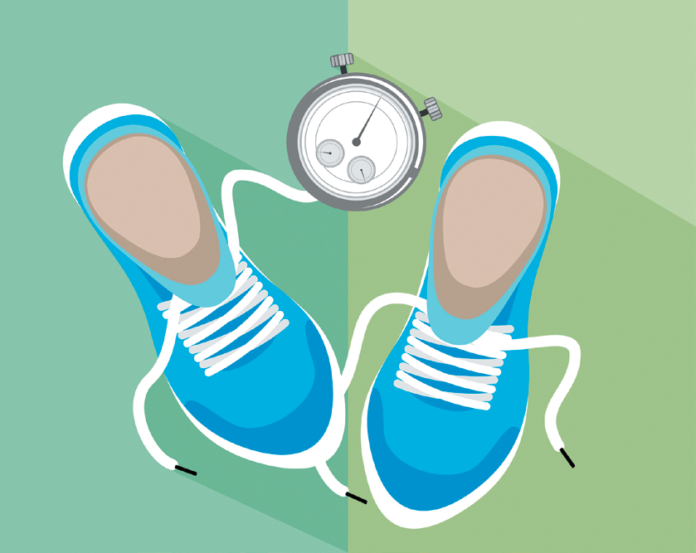Physical activity is integral to good health. High-intensity interval training, or HIIT, is more time-efficient than traditional workouts, and research has shown it has many health benefits, including improving fitness, cardiovascular health, and insulin function, and helping with weight loss.
What is HIIT? HIIT involves performing short, vigorous bursts of activity followed by low-intensity activity or rest. This cycle is repeated for a series of sets. The high-intensity activity should get one’s heart rate up to about 70 to 90 percent of maximum. For the low-intensity period, heart rate should be about 60 to 65 percent of maximum. (A quick estimate of your maximum heart rate is 220 minus your age.) On a stationary bike, for example, a HIIT workout could be 30 seconds of pedaling at maximum effort followed by two to three minutes of easy pedaling, repeated for three to five cycles. Activities and intervals can be adapted to an individual’s current fitness level. Any activity that gets one’s heart rate up, including walking/jogging, using an exercise machine, or performing jumping jacks, sit-ups, push-ups, or squats will work.
The standard physical activity recommendation of 150 minutes of moderate activity or 75 minutes of vigorous activity weekly for good health still stands. HIIT is a type of vigorous activity that has been recognized as a more efficient alternative to traditional moderate-intensity continuous training. With a physician’s approval, HIIT can be an option for all ages and fitness levels, including individuals who are currently sedentary, unfit, or living with a lifestyle-related disease like diabetes or high blood pressure.
The Research. Research shows that engaging in HIIT is an efficient way to achieve health benefits, including weight loss. In one study, overweight and obese participants reduced body fat and waist circumference with both traditional and HIIT workouts in 10 weeks, but those who did HIIT spent 90 minutes per week working out compared to two and a half hours of traditional activity.
HIIT may be good for the brain, too. In a study published in Applied Physiology, Nutrition and Metabolism in 2019, healthy but sedentary adults between the ages of 60 and 88 who completed three HIIT workouts per week for 12 weeks improved memory performance up to 30 percent, while participants who worked out moderately saw no improvement on average.
High-intensity training may help maintain healthy blood-sugar levels and increase glucose metabolism and insulin sensitivity in both healthy individuals and those with prediabetes and diabetes. In one study, for example, glucose metabolism and insulin sensitivity of insulin-resistant participants were raised to match the levels of healthy participants after two weeks of HIIT training.
Exercise Caution. Vigorous physical activity can put people with heart conditions and those who are not regularly active at greater risk of cardiovascular events, according to a recent statement by the American Heart Association. HIIT is an intense workout and should be approached cautiously and progressively: starting slowly and building over time. For those who have not been physically active or who have underlying medical conditions, it’s important to discuss the benefits and risks of any new physical activity program with a physician before beginning.
Give HIIT a Try. Keep in mind that “high intensity” is a relative term that can mean something very different for everyone. With proper precautions, HIIT can be adapted to meet the needs of a variety of fitness levels, ages, and physical limitations. That’s because you choose each variable: the activity (or activities), the length of work and rest, and the duration of the workout.
Always warm up and stretch before starting. It is best to do HIIT while wearing a heart rate monitor (such as those found on fitness tracking bands). If you don’t own a heart rate monitor, you’ll know you’re working hard enough if it becomes difficult to speak during the short high intensity phase. Be sure to let your heart rate drop and your breathing ease before beginning another high-intensity phase. Most importantly, choose activities you enjoy and change them up as necessary to keep yourself interested.
If you’d like to try HIIT, follow these tips:
- Consult your physician before trying HIIT, particularly if you’ve been sedentary or have an underlying medical condition.
- Adapt activities and the length of a HIIT workout to your individual fitness level and physical condition.
- After getting the okay from your physician, get your heart beats-per-minute up to 70 to 90 percent of your maximum heart rate during each high intensity phase. (Maximum heart rate is roughly 200 minus your age.)
- Slow down and work at a heart rate of 60 to 65 percent of maximum between high intensity segments.
- Personalize and vary HIIT to include activities you enjoy that will motivate you

























Thanks for the succinct article on HIIT. As a 75-year old cyclist I use the technique, but still enjoy my long rides too. Please note what seems to be a typo error in the ending summary where 200 is used, instead of 220 minus your age, for your estimated maximal heart rate. Depending on ones level of fitness, that estimate can be way off. As a committed exerciser, I prefer to use my chest strap heart rate monitor and use my actual max HR value during brief intense effort, as recorded by an exercise app.
hi,
please note you first say to calculate max heart rate with 220 minus age, then in box below 200 minus your age.
I think it’s a typo. Could you let me know the correct calculation.
Thank you!
Early in the article max heart rate ic 220 minus your age. In the take charge it drops to 200 minus your age. Does it not make a difference if your resting heart rate is 60 or 80?
This article presents a useful, evidence of HIIT being a healthy approach to cardiac and overall health and wellness. At age 70 my alternate days of intense bicycling of 15 to twenty five miles. I use a sprinting technique coupled with steady, moderate pedalling cadence. This has benefited my cardiac health and over a twenty month period, to lose 45 pounds!. The exercising is coupled with better nutritional choices to facilitate weight loss.
HIIT is an excellent alternative to your normal exercise sessions. It’s very easy to get bored or burned out with the same exercises everyday. With jogging, I’ll run hard for 30-60 seconds, then jog slowly for a minute or two. With weight lifting, on some days I’ll lift heavy with less reps (3-6); on other days, it’s ‘light’ weight with 15- 20 reps.
I gradually increased my running speed in a HIIT routine. As I got to the appropriate high heart rate, I pulled a gluteal tendon and couldn’t run for over 3 months. Your article misses the injury problem entirely.